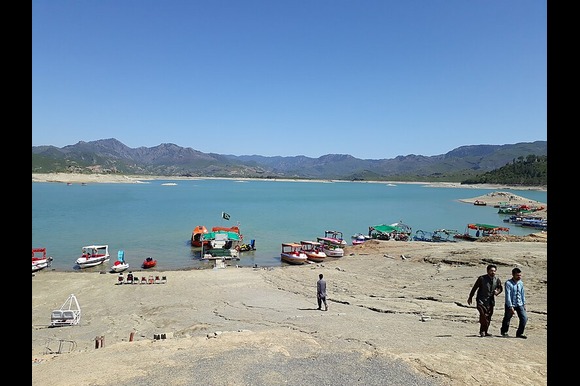
Wikiwand
TAXILA: The water level in Khanpur Dam has dropped to a dangerously low point, now just eight feet above the dead level, triggering serious concerns over a looming water crisis for the civic populations of Rawalpindi and Islamabad.
Water supply for irrigation purposes in both Khyber Pakhtunkhwa (KP) and Punjab had already been halted nearly a month ago. According to the Water and Power Development Authority (Wapda), the dam’s water level was recorded at 1,918 feet on Saturday—well below the conservation level of 1,980 feet and alarmingly close to the dead level of 1,910 feet. The inflow has decreased drastically to only 29 cusecs, while the outflow is being maintained at 106 cusecs.
Due to the declining water level, water sports and recreational activities at the dam—usually popular during the summer heat—have dropped to their lowest levels this year. Wapda officials said that civic agencies in Islamabad and Rawalpindi are currently receiving just 50 cusecs of water, a supply that is now at risk of being completely suspended.
Khanpur Dam typically reaches its peak storage capacity during and immediately after the monsoon season. However, irregular weather patterns, extended dry periods, and poor glacial water management have severely disrupted the inflow cycle. By comparison, in June last year the water level stood around 1,935 feet, with more than double the current inflow rate.
While officials remain cautiously optimistic that the upcoming monsoon rains—expected later this month—will help replenish the dam’s reserves, water experts and hydrologists are issuing broader warnings. They point to climate variability, ineffective catchment area management, and rapidly increasing urban water demand as root causes of the crisis.
“This is not merely a seasonal issue—it’s a deep-rooted structural problem that requires long-term strategic planning,” an irrigation department official stated.
Khanpur Dam serves as a critical source of drinking water for both Islamabad and Rawalpindi and is also responsible for irrigating agricultural lands in Haripur and parts of Punjab. With water levels now at historic lows for mid-June, residents are already starting to experience reduced water pressure, intermittent supply, and a growing reliance on water tankers.
“In some of the low-lying areas, supply hours have already been cut,” said a Capital Development Authority (CDA) official. “If conditions do not improve within the next two weeks, we may be forced to implement emergency water conservation measures.”
Authorities have issued urgent appeals to the public, urging reduced water consumption and discouraging wasteful practices. Activities such as washing cars, watering gardens, and unnecessary flushing of pipelines are being strongly discouraged. Simultaneously, government departments are under increasing pressure to revise water release strategies and launch awareness drives aimed at encouraging public cooperation in conservation efforts.




